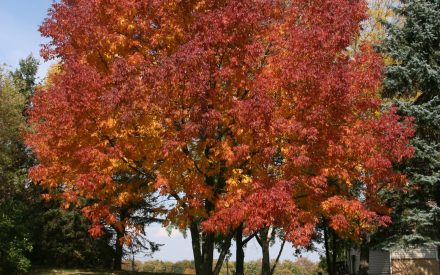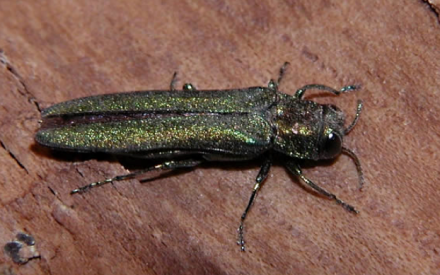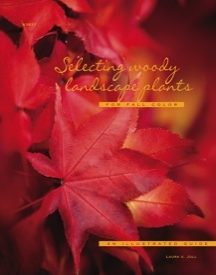
Pest Alert
Authors: PJ Liesch and R. Chris Williamson, UW Entomology
Last Revised: 04/07/2022
X-number: XHT1181
Emerald ash borer insecticide treatment considerations. Several insecticide products are available to homeowners for control of emerald ash borer (EAB). Since the presence and infestation level of EAB is quite difficult to determine at early stages of an infestation, insecticide treatments may be merited to mitigate damage by EAB. However, not all ash trees should be treated as some may be too extensively compromised or in poor condition to receive treatment. Tree location, value, and health, as well as the cost of treatment are all factors to consider. Due to the expense of yearly insecticide treatments, one should consider the value of a particular ash tree in relation to insecticide treatment costs before making any treatments. In addition, consider the health of each tree before treating. Research suggests that insecticide treatments are significantly more effective on EAB-infested ash trees with less than 50% canopy thinning. Insecticide treatments are not suggested for trees with greater than 50% canopy thinning. Trees with greater than 50% canopy thinning should be removed and handled in accordance with local guidelines. For a more detailed discussion on this topic, see University of Wisconsin Garden Facts XHT1215, Is My Ash Tree Worth Treating for Emerald Ash Borer.
Emerald ash borer insecticide treatment options. Insecticide products available for use by homeowners are summarized in Table 1. They include:
- ACECAP Systemic Insecticide Tree Implants (acephate)
- BioAdvanced 12 Month Tree & Shrub Insect Control (imidacloprid)
- BioAdvanced 12 Month Tree & Shrub Protect & Feed (imidacloprid)
- BioAdvanced 12 Month Tree & Shrub Protect & Feed II (imidacloprid + clothianidin)
- Bonide Annual Tree & Shrub Insect Control with SYSTEMAXX (imidacloprid)
- Compare N Save Systemic Tree & Shrub Insect Drench (imidacloprid)
- Ferti-lome Tree and Shrub Drench (imidacloprid)
- Monterey Once a Year Insect Control II (imidacloprid)
- Several other products containing imidacloprid are also currently available
Most of the products available to homeowners are systemic insecticides containing imidacloprid and are applied as soil drenches around the base of ash trees. A few granular products are also available. Recent university research suggests that applications of imidacloprid should be made in spring to be most effective. Research also has demonstrated that soil applications of imidacloprid-containing homeowner products provide excellent EAB protection for ash trees that are less than about 47 inches in circumference [i.e., 15 inches in diameter at breast height (DBH)]. Due to differences in application rates and label restrictions, treatment by a tree care professional (e.g., arborist) may be the best option for larger trees. For best results, treatment of trees should begin before trees become infested and insecticide treatments must be repeated each year to maintain the health of ash trees. Lastly, the products containing imidacloprid have strict limits for the amount that can legally be applied per acre each year. Thus, homeowners can treat and protect several smaller-diameter trees in their yard, but such products are not appropriate for treating many large yard trees or for woodlots or forested areas. Homeowners using imidacloprid-based products will need to carefully check the label each year and measure the size of trees to determine the total amount required.
Be aware that many insecticide products available at hardware stores and garden centers look alike. Carefully check all product labels before purchase to make sure that you have selected the correct product/active ingredient. ALWAYS read and follow the pesticide label directions on the product that you select!
Finally, note that although ACECAP Systemic Insecticide Tree Implants are available to homeowners, we do NOT recommend that homeowners use these because they require physically drilling into a tree during their application each year.
Table 1
Emerald ash borer insecticide treatments available to homeowners
| Product | Active Ingredient | Timing | Type of application |
|
BioAdvanced 12 Month Tree & Shrub Insect Control (D) BioAdvanced 12 Month Tree & Shrub Protect & Feed (D or G) Bonide Annual Tree & Shrub Insect Control with SYSTEMAXX (D) Compare N Save Systemic Tree & Shrub Systemic Insect Drench (D) Ferti-lome Tree & Shrub Drench (D) Monterey Once a Year Insect Control II (D) Other related products | Imidacloprid | Mid-April to mid-May |
Soil Drench (D) or Granular (G) |
| BioAdvanced 12 Month Tree & Shrub Protect & Feed II (D or G) |
Imidacloprid + Clothianidin | Mid-April to mid-May | Soil Drench (D) or Granular (G) |
| ACECAP Systemic Insecticide Tree Implants | Acephate | Mid-May to mid-June | Trunk Implant |
Other emerald ash borer treatment options. Homeowners may also contact a certified arborist or certified pesticide applicator to treat their trees. See www.waa-isa.org for a list of certified arborists in Wisconsin. Professionals have access to some products that are not available to homeowners, including products that can protect trees for multiple years.
The University of Wisconsin does not endorse commercially available insecticide products over those available directly to homeowners. Products discussed in this fact sheet have been evaluated in university research tests on EAB.
For more information on controlling emerald ash borer: See eab.russell.wisc.edu, www.emeraldashborer.wi.gov or www.emeraldashborer.info or contact your county Extension agent.
Download Article





 Is My Ash Tree Worth Treating for Emerald Ash Borer?
Is My Ash Tree Worth Treating for Emerald Ash Borer? Professional Guide to Emerald Ash Borer Insecticide Treatments
Professional Guide to Emerald Ash Borer Insecticide Treatments Selecting Woody Landscape Plants for Fall Color: An Illustrated Guide
Selecting Woody Landscape Plants for Fall Color: An Illustrated Guide Choosing Trees and Shrubs Under Powerlines
Choosing Trees and Shrubs Under Powerlines


